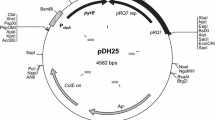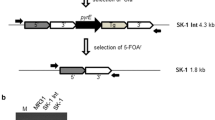Abstract
We describe the development of genetic tools (electroporation, conjugation, vector for targeted gene replacement) for use in the psychrophile Psychrobacter arcticus 273-4 to test hypotheses about cold adaptation. Successful electroporation only occurred with nonstandard parameters, such as: electrocompetent cells freshly prepared from stationary-phase cultures, high field strengths (25 kV cm−1), long recovery times (16–24 h), and selection with low concentrations of antibiotics. Transformation frequencies were greatly affected by a methylation-dependent restriction barrier homologous to DpnI. The vector pJK100 (which was self-transmissible and contained a Pir-dependent R6K origin of replication) proved effective as a suicide plasmid that could be used to recombine mutations into the P. arcticus 273-4 genome. We used this vector for targeted replacement of dctT, the substrate-binding periplasmic subunit of a TRAP (tripartite ATP-independent periplasmic) transporter (which we have named dctTUF), as it was more highly expressed at cold temperatures. The replacement of dctT (with kan) decreased the rate of growth at low temperatures in mineral medium with glutamate, acetate, butyrate, and fumarate, but not with pyruvate suggesting that DctTUF participates in the transport of glutamate, acetate, butyrate, and fumarate at cold temperatures. This is the first report to demonstrate the creation of site-specific mutants in the genus Psychrobacter, their affect on low-temperature growth, and a substrate range for TAXI proteins of TRAP transporters.






Similar content being viewed by others
References
Aricha B, Fishov I, Cohen Z, Sikron N, Pesakhov S, Khozin-Goldberg I, Dagan R, Porat N (2004) Differences in membrane fluidity and fatty acid composition between phenotypic variants of Streptococcus pneumoniae. J Bacteriol 186:4638–4644
Atlas RM (1993) Handbook of microbiological media. CRC Press, Boca Raton
Bakermans C, Ayala-del-Río HL, Ponder MA, Vishnivetskaya T, Gilichinsky D, Thomashow MF, Tiedje JM (2006) Psychrobacter cryohalolentis sp nov. and Psychrobacter arcticus sp. nov. isolated from Siberian permafrost. Int J Sys Evol Microbiol 56:1285–1291
Bakermans C, Tollaksen SL, Giometti CS, Wilkerson C, Tiedje JM, Thomashow MF (2007) Proteomic analysis of Psychrobacter cryohalolentis K5 during growth at subzero temperatures. Extremophiles 11:345–354
Bakermans C, Tsapin AI, Souza-Egipsy V, Gilichinsky DA, Nealson KH (2003) Reproduction and metabolism at–10°C of bacteria isolated from Siberian permafrost. Environ Microbiol 5:321–326
Beney L, Mille Y, Gervais P (2004) Death of Escherichia coli during rapid and severe dehydration is related to lipid phase transition. Appl Microbiol Biotech 65:457–464
Bergholz PW, Bakermans C, Tiedje JM (2008) Resource efficiency and molecular motion dominate the transcriptome response during growth below 0°C in Psychrobacter arcticus 273-4 (submitted)
Blatny J, Brautaset T, Winther-Larsen H, Karunakaran P, Valla S (1997) Improved broad-host-range RK2 vectors useful for high and low regulated gene expression levels in Gram-negative bacteria. Plasmid 38:35–51
Calvin NM, Hanawalt PC (1988) High-efficiency transformation of bacterial-cells by electroporation. J Bacteriol 170:2796–2801
Chandler MS (1991) New shuttle vectors for Haemophilus influenzae and Escherichia coli: P15A-derived plasmids replicate in H. influenzae Rd. Plasmid 25:221–224
Cohen MF, Meeks JC, Cai YA, Wolk CP (1998) Transposon mutagenesis of heterocyst-forming filamentous cyanobacteria. Methods Enzymol 297:3–17
Denef VJ, Klappenbach JA, Patrauchan MA, Florizone C, Rodrigues JLM, Tsoi TV, Verstraete W, Eltis LD, Tiedje JM (2006) Genetic and genomic insights into the role of benzoate-catabolic pathway redundancy in Burkholderia xenovorans LB400. Appl Environ Microbiol 72:585–595
Ditta G, Stanfield S, Corbin D, Helinski DR (1980) Broad host range DNA cloning system for Gram-negative bacteria: construction of a gene bank of Rhizobium meliloti. Proc Natl Acad Sci USA 77:7347–7351
Elhai J, Wolk CP (1988) A versatile class of positive-selection vectors based on the nonviability of palindrome-containing plasmids that allows cloning into long polylinkers. Gene 68:119–138
Figurski DH, Helinski DR (1979) Replication of an origin-containing derivative of plasmid RK2 dependent on a plasmid function provided in trans. Proc Natl Acad Sci USA 76:1648–1652
Harris FM, Best KB, Bell JD (2002) Use of laurdan fluorescence intensity and polarization to distinguish between changes in membrane fluidity and phospholipid order. Biochim Biophys Acta Biomembr 1565:123–128
He HJ, Gordon R, Gow JA (2001) The effect of temperature on the fatty acids and isozymes of a psychrotrophic and two mesophilic species of Xenorhabdus, a bacterial symbiont of entomopathogenic nematodes. Can J Microbiol 47:382–391
Ishii A, Ochiai T, Imagawa S, Fukunaga N, Sasaki S, Minowa O, Mizuno Y, Shiokawa H (1987) Isozymes of isocitrate dehydrogenase from an obligately psychrophilic bacterium, Vibrio sp strain Abe-1—purification, and modulation of activities by growth-conditions. J Biochem 102:1489–1498
Ito M, Nagane M (2001) Improvement of the electro-transformation efficiency of facultatively alkaliphilic Bacillus pseudofirmus OF4 by high osmolarity and glycine treatment. Biosci Biotech Biochem 65:2773–2775
Kelly D, Thomas G (2001) The tripartite ATP-independent perimplasmic (TRAP) transporters of bacteria and archaea. FEMS Microb Rev 25:405–424
Kues U, Stahl U (1989) Replication of plasmids in Gram-negative bacteria. Microbiol Rev 53:491–516
Liang CC, Lee WC (1998) Characteristics and transformation of Zymomonas mobilis with plasmid pKT230 by electroporation. Bioprocess Eng 19:81–85
Lin JJ, Somero GN (1995) Temperature-dependent changes in expression of thermostable and thermolabile isozymes of cytosolic malate-dehydrogenase in the eurythermal goby fish Gillichthys mirabilis. Physiol Zool 68:114–128
Marcus NH (1977) Temperature induced isoenzyme variants in individuals of sea-urchin, Arbacia punctulata. Comp Biochem Physiol B Biochem Mol Biol 58:109–113
Marx CJ, Lidstrom ME (2002) Broad-host-range cre-lox system for antibiotic marker recycling in Gram-negative bacteria. Biotechniques 33:1062–1067
Mulder NJ, Apweiler R, Attwood TK, Bairoch A, Bateman A, Binns D, Bradley P, Bork P, Bucher P, Cerutti L, Copley R, Courcelle E, Das U, Durbin R, Fleischmann W, Gough J, Haft D, Harte N, Hulo N, Kahn D, Kanapin A, Krestyaninova M, Lonsdale D, Lopez R, Letunic I, Madera M, Maslen J, McDowall J, Mitchell A, Nikolskaya AN, Orchard S, Pagni M, Ponting CP, Quevillon E, Selengut J, Sigrist CJA, Silventoinen V, Studholme DJ, Vaughan R, Wu CH (2005) InterPro, progress and status in 2005. Nucl Acids Res 33:D201–D205
Myers C, Myers J (1997) Replication of plasmids with the p15A origin in Shewanella putrefaciens MR-1. Lett Appl Microbiol 24:221–225
Nedwell DB (1999) Effect of low temperature on microbial growth: lowered affinity for substrates limits growth at low temperature. FEMS Microb Ecol 30:101–111
Ochiai T, Fukunaga N, Sasaki S (1979) Purification and some properties of two NADP+-specific isocitrate dehydrogenases from an obligately psychrophilic marine bacterium, Vibrio sp. strain Abe-1. J Biochem 86:377–384
Ochiai T, Fukunaga N, Sasaki S (1984) Two structurally different NADP-specific isocitrate dehydrogenases in an obligately psychrophilic bacterium, Vibrio sp strain Abe-1. J Gen Appl Microbiol 30:479–487
Ponder MA, Gilmour SJ, Bergholz PW, Mindock CA, Hollingsworth R, Thomashow MF, Tiedje JM (2005) Characterization of potential stress responses in ancient Siberian permafrost psychroactive bacteria. FEMS Microbiol Ecol 53:103–115
Stretton S, Techkarnjanaruk S, McLennan AM, Goodman AE (1998) Use of green fluorescent protein to tag and investigate gene expression in marine bacteria. Appl Environ Microbiol 64:2554–2559
Tatebe W, Muraji M, Fujii T, Berg H (1995) Reexamination of electropermeabilization on yeast cells—dependence on growth-phase and ion concentration. Bioelectrochem Bioenerg 38:149–152
Tutino ML, Duilio A, Moretti MA, Sannia G, Marino G (2000) A rolling-circle plasmid from Psychrobacter sp. TA144: evidence for a novel Rep subfamily. Biochem Biophys Res Commun 274:488–495
Tyurin MV, Desai SG, Lynd LR (2004) Electrotransformation of Clostridium thermocellum. Appl Environ Microbiol 70:883–890
Vanounou S, Pines D, Pines E, Parola AH, Fishov I (2002) Coexistence of domains with distinct order and polarity in fluid bacterial membranes. Photochem Photobiol 76:1–11
Vishnivetskaya T, Kathariou S, McGrath J, Gilichinsky D, Tiedje JM (2000) Low-temperature recovery strategies for the isolation of bacteria from ancient permafrost sediments. Extremophiles 4:165–173
Wei MQ, Rush CM, Norman JM, Hafner LM, Epping RJ, Timms P (1995) An improved method for the transformation of Lactobacillus strains using electroporation. J Microbiol Meth 21:97–109
Welsh DT (2000) Ecological significance of compatible solute accumulation by micro-organisms: from single cells to global climate. FEMS Microbiol Rev 24:263–290
Whyte LG, Inniss WE (1994) Electroporation and its effect on the psychrotrophic bacterium Bacillus psychrophilus. Can J Microbiol 40:83–89
Xue GP, Johnson JS, Dalrymple BP (1999) High osmolarity improves the electro-transformation efficiency of the Gram-positive bacteria Bacillus subtilis and Bacillus licheniformis. J Microbiol Meth 34:183–191
Yamawaki H, Tsukuda H (1979) Significance of the variation in isozymes of liver lactate-dehydrogenase with thermal acclimation in goldfish—thermostability and temperature dependency. Comp Biochem Physiol B Biochem Mol Biol 62:89–93
Acknowledgments
This work was supported through membership in the NASA Astrobiology Institute. C. Bakermans was supported by a National Academy of Sciences National Research Council research associateship. We thank J. Klappenbach for providing pJK100 and E. coli WM3064.
Author information
Authors and Affiliations
Corresponding author
Additional information
Communicated by T. Matsunaga.
Electronic supplementary material
Below is the link to the electronic supplementary material.
Rights and permissions
About this article
Cite this article
Bakermans, C., Sloup, R.E., Zarka, D.G. et al. Development and use of genetic system to identify genes required for efficient low-temperature growth of Psychrobacter arcticus 273-4. Extremophiles 13, 21–30 (2009). https://doi.org/10.1007/s00792-008-0193-3
Received:
Accepted:
Published:
Issue Date:
DOI: https://doi.org/10.1007/s00792-008-0193-3




